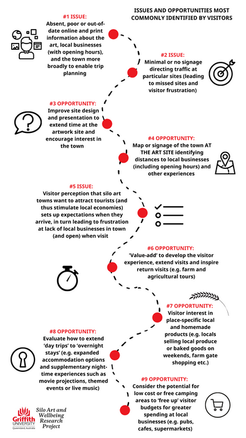

Rone in Lascelles

Kaff-eine in Rosebery

Adnate in Sheep Hills
ABOVE: Images Karen Simpson (2019)

SILO ART
AND WELLBEING
Research Project
RESEARCH TEAM:
Dr Amelia Green and Professor Scott Weaven
Griffith University Ref No: 2002/824
The Australian silo art phenomenon and the aim of this research
Six years have passed since Australia’s first silo art site in Northam, Western Australia (completed March 2015). The Australian silo art phenomenon continually attracts widespread media coverage and public attention throughout the country and overseas. Silo art has even been referred to as a ‘media darling’.
With 48 completed sites across five states as of June 2021, and at least a further 15 additional sites in the planning stages, there is no sign of this movement slowing down.
Many small towns undertake silo art projects to attract visitors to forgotten places, create a lifeline for struggling local businesses and revive community pride.
Public and media discussion often emphasise tourist attraction and immediate local business stimulation as the primary outcomes of these projects for rural and regional towns (many of which are home to several hundred residents or less).
However, public and independent evaluation of silo art projects is lacking. Therefore, the many community groups, Local Councils, Shires, tourism boards, funding bodies, arts organisations, artists and citizens involved in (or impacted by) these projects are presently unable to access a solid evidence-base to guide future organising and action.
This report represents the first step in providing much needed empirical and critical investigation into the social and economic impacts of Australian silo art.
Specifically, this research aims to explore (1) how visitors and local communities experience silo art and (2) the impacts of silo art experiences of the well-being of visitors and communities.

THE DATA: Interviews and the first national Australian silo art survey
This research focuses on the experiences and perceptions of silo art visitors, residents who live in silo art towns, and local business owners:
-
Stage One: 61 video/online and phone interviews
-
Stage Two: A combined total of 1,140 responses to the first national Australian silo art survey
714 people who have visited one or more silo art site(s)
243 residents (average of 5 residents per silo art site)
183 local business owners/managers (average of 4 per site)
The findings within the first report draw on both quantitative and qualitative data:
-
Quantitative results (percentages etc.) of multiple choice survey questions provide instrumental insight.
-
Responses to open-ended survey and interview questions that allow participants to respond in their own words (i.e. qualitative data) are necessary to delve deeper, and build a more comprehensive understanding of silo art from both visitor and community perspectives.

The Zookeeper and Drapl in Thallon, VIC- Image Alana Beutel (2020)

THE FINDINGS:
The findings presented in the first public report are structured in four main parts:
-
The five elements that distinguish Australian silo art in the eyes of visitors and communities
-
Visitor perspectives and impacts
-
Local community perspectives and impacts
-
Broader critical issues, challenges and opportunities identified by both visitors and local communities
Adnate in Sheep Hills, VIC - Image Adrian Tusek (2020)

Brenton See in Newdegate, WA - Image KDog Photography
RECOMMENDATIONS:
The report presents multiple recommendations for Local Councils, Shires, community groups, tourism boards, local businesses, funding bodies, arts organisations, artists and indeed all stakeholders with a interest in supporting and sustaining the potential benefits of silo art for visitors, local communities and Australia more broadly.
Examples of infographics within the report
Click to expand and read further comments regarding each infographic
Street Studies -
International Research Network
Street Studies is a NFP social enterprise based in Copenhagen, Denmark.
I previously led an International Research Network that Street Studies created in 2019.
This informal and passion-based network facilitated connections and collaboration between researchers, artists, practitioners and policymakers involved or interested in the following the three interrelated themes below.

Main support functions:
-
Interdisciplinary discussion
-
Connect with researchers approaching similar or related topics from diverse perspectives - expand your thinking and keep pushing methodological and conceptual boundaries
-
Sparring on research grants
-
Unique communication platforms
Founding members
-
Dr Laura Ripoll Gonzalez (Community, Events, Place Development, University of Tasmania)
-
Dr Ricardo Lopez (Architecture, Urban Studies & Creative Culture, University of Lisboa)
-
Dr Zareen Thomas (Sociocultural Anthropology, University of Connecticut)
Events:
The network's flagship event took place late July 2019, during the Copenhagen edition of Meeting of Styles (the world's largest graffiti and street art festival), which Street Studies organise.
Speakers and topics in 2019 included:
* Dr Ricardo Lopes and Professor Pedro Costa (University of Lisboa, Portugal) talking about the recent institutionalisation of urban art in Lisbon and evolution of graffiti and murals in the old industrial city of Barreiro.
* Cynthia Nikitin (Senior Vice President, Project for Public Spaces, New York City) talking about creative placemaking as an integrative approach to urban planning and community building that stimulates local economies and leads to increased innovation, cultural diversity and civic engagement.























